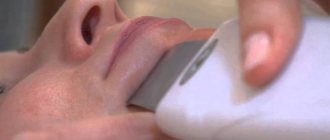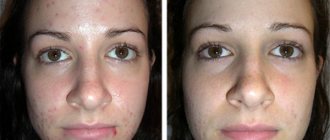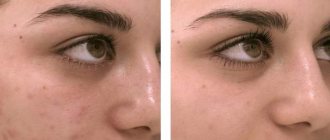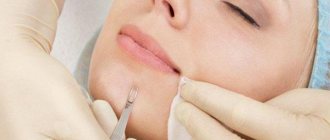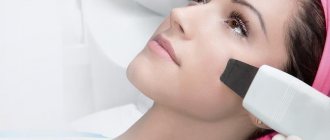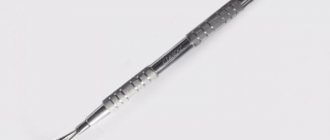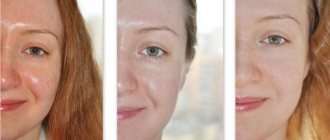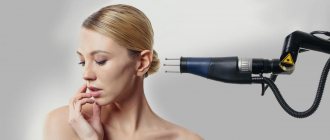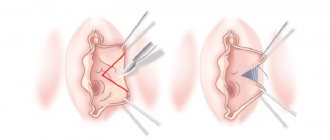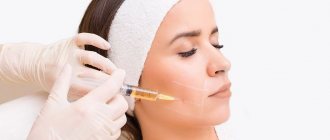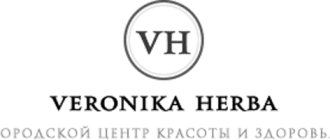September 27, 2019
Why is home skin care not enough? There are a number of reasons for this, which cause constant inflammation, a feeling of tightness and fatigue of the skin:
- poor lifestyle: diet, bad habits and insufficient sleep;
- hormonal imbalances or hereditary predisposition;
- constant stress and poor environment;
- improper skin care, lack of basic discipline: poor-quality makeup removers, lack of nourishing care, incorrectly selected decorative cosmetics.
In these conditions, it is important not just to follow the recommendations from beauty blogs or a salon manicurist, but to consult a cosmetologist. After all, only he will select the right care, taking into account individual characteristics and test results. And in case of complex inflammatory processes, he will prescribe treatment and facial cleansing procedure.
Content:
- The essence of the procedure
- Advantages of mechanical cleaning
- Flaws
- Who can have the procedure
- Stages of the procedure
- Skin preparation
- Steaming
- Cleansing
- The final stage
- How often can mechanical cleaning be done?
- How to care
- Consequences
Facial care begins with cleansing the skin. You need to wash your face regularly or wipe it with toner, remove makeup every evening, and periodically do peeling and cleansing masks. But even careful regular care does not provide deep cleansing of pores. Dust gets into them, mixes with skin secretions and clogs them. With combination and oily skin, clogged pores often become inflamed and acne appears. If there are no inflammatory processes, black dots are noticeable on the face. With dry skin, the blockage of pores is hardly noticeable, but the supply of oxygen to the deep layers of the dermis is reduced, and the complexion deteriorates. To completely remove all impurities and cleanse the pores, you need to regularly have your skin cleaned by a cosmetologist. In the VOSK beauty salons in Moscow, gentle and painless ultrasonic cleaning is performed, but sometimes cosmetologists recommend a mechanical method or a combined procedure. It provides deeper cleansing than ultrasound.
Skin care after mechanical cleansing
It takes a certain period of time for the skin to fully recover. Existing redness and crusts on the skin of the face should absolutely not be touched, as this is fraught with the appearance of scars.
You cannot wash your face for 9 or 10 hours after the procedure. The effect of protective masks and restorative creams that were applied by a cosmetologist continues. For three whole days you should forget about the solarium and sun exposure. Otherwise, age spots may appear on the face.
No alcohol-containing tonics or lotions should be used. To speed up the skin healing process, you can use light nourishing creams that contain extracts or soothing components. A cosmetologist will help you make a choice.
About the procedure
Mechanical (manual, manual) or combined, with peeling, cleaning is used for deep cleansing of the epidermis. It is recommended for acne, black or white sebaceous plugs that clog pores. To remove them, mechanical action is applied to the skin with your hands or a specialized instrument - a Uno spoon.
Cleaning causes unpleasant painful sensations and injures the skin. To reduce them to a minimum, you need to choose a cosmetologist with experience and “light hands.” Attempts to squeeze out sebaceous plugs on your own increase the risk of infection and provoke the development of an inflammatory process: there is more damage and it takes longer to heal.
You can sign up for combined or manual cleaning for rashes, blackheads in the décolleté area, on the shoulders and back.
Advantages
Mechanical skin cleaning was carried out back in Ancient Greece. And today, thousands of women in different countries come to cosmetologists every day for this procedure, giving it preference over the hardware, despite the innovative ultrasound equipment in salons, peelings, masks and creams.
Benefits of manual cleaning:
- release of sebaceous ducts to the very base - ultrasonic cleansing does not give such an effect;
- improving blood circulation and oxygen supply to cells helps to improve the health of the dermis, smooth out the relief, increase tone and reduce the number of wrinkles;
- normalization of the sebaceous glands, uniform distribution of sebum in combination skin types;
- The cost of manual cleaning is lower than ultrasonic cleaning - it does not require specialized equipment.
Flaws
Mechanical cleaning has several disadvantages:
- the procedure cannot be classified as relaxing - squeezing out sebaceous plugs causes unpleasant sensations;
- injury to the epidermis - the formation of microtraumas, the appearance of redness is inevitable;
- allergic reactions to the drugs used, substances contained in the masks are possible - the risk of allergic manifestations increases when performing a combined procedure;
- The recovery period lasts from 2-3 days to a week.
Unpleasant moments when using a mechanical method of cleaning pores cannot be avoided. But the degree of their severity depends on the qualifications of the cosmetologist and the threshold of pain sensitivity. After a correctly performed procedure, redness and damage disappear quickly, scars and severe swelling do not form, and the appearance noticeably improves.
How to choose a cosmetologist?
To clean your face, contact a medical cosmetologist. Performing the procedure by a doctor with extensive experience is a guarantee of restoring facial skin health and further proper care. Lack of basic knowledge about the structure of the skin, unprofessional use of laser or ultrasound can seriously harm appearance and health.
In addition, do not forget that the effectiveness of the procedure also depends on you. The doctor will talk about preparation for the procedure, dietary restrictions and post-cleaning care. Your task is to responsibly follow all recommendations, without missing a single nuance. The beauty industry is like playing sports: if you skip a workout, the pounds come back, you forget about makeup remover and break your diet, and inflammation and acne will return even after cleansing. Listen to cosmetologists and be beautiful! Healthy skin means self-confidence in any situation.
Indications
It is recommended to use the manual method of cleaning the epidermis less frequently than the ultrasonic method. But if you have problem skin, it is better to come for a procedure that will not hide defects for a few days, but will improve the condition, normalize sebum secretion and oxygen supply to cells.
Manual cleaning is recommended:
- for combination or oily skin types, even in the absence of rashes;
- for acne, acne, pimples;
- with an unhealthy complexion;
- for wen and milia;
- with clogged pores, sebaceous plugs can be black or white;
- with a decrease in the elasticity of the dermis.
The mechanical method is most effective in combating teenage rashes. During puberty, a girl or boy should be made an appointment with a cosmetologist to get advice on skin care and start cleaning it in a timely manner, before acne appears.
What to do after cleansing your face and how to care for your skin
How to properly care for your face after a cosmetologist cleans your skin? After all, we have already found out that the epidermis becomes extremely sensitive, it needs time and quality care for rapid recovery. And what is most important is to achieve the desired result.
What to do after cleansing your face depends directly on the type of procedure. But there are also general rules of behavior.
General recommendations
Immediately after cleansing the face, the cosmetologist applies a special mask, selected according to the skin type, which will help get rid of side effects, soothe the irritated epidermis, moisturize and nourish it with the necessary elements. Here are the rules for home care after mechanical or hardware facial cleansing:
- A few hours after cleansing, or better yet a day, leave your face alone. The skin has already experienced severe stress and there is no need to irritate it further;
- Treat the entire surface of the face with lotion without alcohol components. If necessary, use alcohol-containing products only on local areas (wounds, open pimples, areas of inflammation for disinfection purposes);
- rinse your face with decoctions of medicinal herbs or make compresses from such compositions. Chamomile, calendula, St. John's wort, celandine, string, plantain are suitable;
- As we have already found out, you can’t wash your face after cleansing for two or three days. Cosmetologists recommend using high-quality mineral or melt water for water procedures after this time. You can add a few drops of lemon juice or apple cider vinegar to the liquid. This is additional protection against infection and stimulation of regeneration processes;
- regularly apply moisturizing and nourishing creams to your face according to your skin type;
- Make masks from natural ingredients 1-2 times a week. You can prepare them yourself, taking into account individual characteristics and preferences.
Now let's look at the nuances of skin care after different types of cleansing.
Recovery after mechanical facial cleansing
Manual or manual cleaning is the most effective, but also the most traumatic method of eliminating defects. In addition to following the general rules, after mechanical cleansing of the face, you need to take into account some specific skin care recommendations:
- careful adherence to hygiene rules. Open wounds can become infected. To prevent this from happening, you need to touch your face less, treat the skin with lotions without alcohol, but with antiseptic components;
- wipe your face with decoctions of medicinal herbs, make compresses from these decoctions (warm or cool, but not hot!). These measures will help quickly get rid of swelling and redness that may be present for two to three days;
- remove excess sebum with alcohol-free tonics;
- when new acne appears, treat the skin twice a day with Metrogyl gel in problem areas;
- Moisturizing products according to your skin type will help get rid of flaking or excessive dryness;
- gel with aloe vera extract will contribute to rapid regeneration;
- Once a week it is recommended to make masks from cosmetic clay. This will help eliminate sebaceous secretions and improve tissue regeneration.
There is no need to treat the skin with specific products after cleansing. The use of medications is indicated only in case of complications. By correctly using facial care products, you minimize all possible risks and speed up the process of natural restoration of the epidermis.
Recovery after vacuum cleaning
Vacuum facial cleansing is very similar in effect to manual cleansing. However, it has both its pros and cons. Among the advantages are painlessness, massage effect, improvement of metabolic processes, lymphatic drainage, stimulation of blood circulation. Among the disadvantages, perhaps, there is only one - during such a procedure it will not be possible to remove deep comedones, sebaceous plugs and millia.
It is easier to restore the skin after vacuum facial cleansing than after mechanical cleansing - the device improves regeneration processes at the cellular level without causing damage to the skin.
Recommended:
- Apply moisturizing and nourishing products to your face depending on your skin type and age. The effectiveness of the active components increases significantly due to the stimulation of internal processes, cleansing the keratinized epidermis from the upper layer;
- apply special masks with a calming effect. This will help relieve irritation and swelling;
- Before going outside, use sunscreen to avoid the appearance of age spots.
And, of course, compliance with the general rules of care.
Recovery after ultrasonic cleaning
Ultrasonic facial cleansing is the most popular, safe and least traumatic method. It is also called the “weekend procedure”, since the recovery period does not exceed several days, in extremely rare cases – a week.
Please pay attention! Ultrasound cleaning has many contraindications and warnings. Before the session, the cosmetologist must find out all the nuances associated not only with skin problems, but also with the general state of health.
The rules of behavior and care are very simple:
- compliance with general recommendations – a priori;
- do not wash your face for a day. And in the following days, use only high-quality water without chemical impurities (that is, not tap water) for these purposes. Do not use soap, but only special cleansers with a neutral pH;
- wipe your face with tonics and lotions without alcohol;
- twice a week, make moisturizing and nourishing masks with seaweed and cosmetic clay;
- treat your face with decoctions of medicinal herbs that have a calming effect;
- Use sunscreen with an SPF of at least 25.
Direct sunlight or exposure to ultraviolet radiation in a solarium for the first three to four weeks can cause pigmentation to appear.
Recovery after laser cleaning
You need to take special care of your facial skin after laser cleaning. After all, the light beam removes all keratinized epidermal tissue. The surface becomes very sensitive to external influences.
That's why:
- You can wash your face after laser facial cleansing only after four to five days. Before this, wipe your face with tonics or lotions without alcohol;
- treat the surface with products containing aloe vera. The plant extract stimulates regenerative processes and promotes rapid restoration of the epidermis;
- Do not peel or use scrubs for a month;
- For six months after the procedure, use sunscreen with an SPF factor of at least 30 in winter, and at least 45-50 in summer;
- regularly (twice a week) make moisturizing, nourishing masks;
- Apply cream to your face twice a day according to your skin type.
This is approximately how you need to take care of your face after cleansing your face at a cosmetologist, in order to make the recovery process as fast and comfortable as possible.
Contraindications
Manipulations that involve mechanical impact on the skin of the face are undesirable for certain diseases and during certain periods. Before carrying out the procedure, the cosmetologist clarifies whether there are any contraindications to cleaning. They can be absolute and relative. The absolute ones include:
- pregnancy at any stage;
- bronchial asthma;
- diseases of the circulatory system;
- eczema;
- dermatitis;
- increased fragility of blood vessels - the cosmetologist will recommend other cleaning methods;
- dry, flaky skin - it is well cleaned by ultrasonic waves;
- boils.
Relative contraindications include high blood pressure - it can be stabilized by taking medications and measured before the procedure. It is not recommended to sign up for a cleanse during your period. If the pain threshold is low, the woman makes the decision on her own, having previously discussed the possibilities of other procedures with the cosmetologist.
Who is recommended for mechanical facial cleansing?
Patients with problematic facial skin resort to mechanical cleansing. This popular cosmetic procedure can be performed at any age. An exception is the period of pregnancy of a woman and the time before puberty. When is such treatment necessary for facial skin?
- Pores are enlarged and dirty.
- The face is full of blackheads and comedones.
- Acne is in the healing stage.
- The tone of the skin is reduced and turgor is deteriorated.
- The face has become uneven in color and the skin looks faded.
Order of conduct
To reduce the pain of the procedure, trauma to the skin, and reduce the risk of infection, mechanical cleansing of the face is carried out in several stages:
- removing makeup, cleaning the face, neck, décolleté with tonic and thorough disinfection;
- if a combined type of procedure is performed, a light superficial peeling with a small concentration of acid is applied to the face;
- steaming - softens the rough surface layer of the dermis, facilitates easy removal of dead cells;
- mechanical cleansing of pores;
- skin disinfection;
- applying a mask that soothes the skin and tightens pores.
After the procedure, it is not recommended to overcool your face. If cleaning is done in winter, in severe frost, you need to stay warm for another 20-30 minutes.
Benefits of cosmetic cleansing
At home, it is impossible to clean the skin correctly, but it can easily become damaged and infected. Here are the main differences between home “cleaning” and cosmetology services:
- Stages
Cleaning in a salon environment is a long and painstaking work of a doctor: from selecting a treatment method to cleansing the skin, exfoliation, removing blackheads and inflammatory products, applying masks and massage. Home manipulations are unlikely to resemble any of the above.
- Getting rid of comedones
Without damage to the skin and the possibility of further infection. The doctor uses manual techniques, chemicals and devices. It is impossible to achieve such an effect at home.
- Correct composition
Store-bought exfoliates or all kinds of preparations with salicylic acid can improve a little, but, unfortunately, do not cure problem skin. In the worst case, you can get burns. Professional gels and masks contain a completely different composition and are selected taking into account all the individual characteristics of the skin.
Preparation
Before the procedure, the cosmetologist disinfects the instruments and takes out a sterile napkin. The master puts on sterile latex gloves. But in some women, contact with latex provokes allergic reactions. Warn the cosmetologist before the procedure. Mechanical cleaning can be done without gloves. But you need to thoroughly disinfect your hands.
Before visiting the salon, no special preparation is required for cleaning carried out by mechanical or ultrasonic methods. It is not necessary to remove makeup if a woman feels uncomfortable without it. The specialist in the salon will do this in a few minutes. There is no point in pre-steaming the skin at home. This should be done immediately before mechanical cleaning, immediately after disinfection.
Steaming
After removing makeup and disinfection, applying peeling using a combined cleaning method, the upper layer of the dermis needs to be steamed. This stage lasts several minutes if wet steam is used, and about 10-15 minutes when applying thermal heating gel. Thermal warming gel prevents excessive fluid loss.
But with dilated vessels on the face, their close location, with dry, thin or sensitive skin with rosacea, cold hydrogenation is used to loosen the upper layer of the dermis and remove dead cells. The gel does not increase the temperature on the surface of the epidermis, but saturates the cells with moisture. They swell, increase in volume, and intercellular connections weaken. The gel is applied for 20-25 minutes. The duration of the mechanical procedure increases slightly, and the morbidity decreases. After steaming, it is advisable to do brossage - mechanical treatment with a rotating brush.
What to do about pigmentation after peeling
If you notice dark spots after the session, cancel all following procedures and make an appointment with your doctor.
It is only possible to remove this visual defect in a comprehensive manner, but before starting treatment it is necessary to undergo a rehabilitation period so that the skin can recover. How to remove pigmentation after peeling:
- drug treatment;
- hardware cosmetology;
- applications of creams, ointments or gels.
Cosmetology
You can correct skin pigmentation after peeling using the following cosmetic methods:
- mesotherapy;
- laser peeling;
- photorejuvenation;
- plasma lifting;
- TCA peels.
Let's consider each option in more detail.
Mesotherapy
These are injections of vitamin cocktails that slow down skin aging and make it more elastic and clear. Typically, the injection product contains hyaluronic and succinic acids, antioxidants and vitamin complexes.
However, if pigmentation appears after peeling, it will not be possible to get rid of it quickly: 8–10 mesotherapy procedures will be required with a break of 2 weeks between each session.
Laser technologies
Laser resurfacing is most often chosen to combat age spots and is considered one of the most effective methods for smoothing the skin. However, this procedure has a number of contraindications, including pregnancy and lactation, and is also very difficult to tolerate for most patients, since it is traumatic and painful.
During the session, the laser destroys the stratum corneum of cells where melanocytes accumulate. As a result, the spot brightens, and after a few procedures disappears completely.
Photorejuvenation
The method is based on the impact of light pulses on the skin. It removes pigment spots, stars, and consequences after TCA peeling. The skin brightens and tightens, the water balance is normalized.
Before starting the procedure, a cooling gel is applied to the face. Then they use a special device that creates flashes of light. They pass through the layers of the epidermis and destroy particles of melanin - a substance due to the accumulation of which pigment spots are formed.
The procedure takes about 30 minutes, without damaging the skin. Redness remains at the site of exposure to light pulses, but this goes away after a few hours. Not as aggressive as laser resurfacing.
Plasmolifting
The method involves the subcutaneous injection of the patient's own platelet-rich plasma. The patient's blood is taken from a vein and centrifuged for 15-20 minutes, separating the plasma. Then it is injected under the skin, pre-mixed with a special buffer. Swiss compounds are considered the most powerful. The procedure is aimed at improving the skin with the help of substances contained in the human body, increasing local immunity, after which the skin looks healthy and fresh.
TCA peeling
The method is based on the use of trichloroacetic acid. In addition to it, the composition includes lactic and salicylic acids, which should minimize the risk of any side effects.
It comes in dosages of 7 and 14%. But even the weakest peeling requires skin restoration for at least a day. Effectively renews the skin, eliminating pigmentation, but requires vigilant monitoring, since peeling itself is a controlled burn of the skin.
Each of the listed methods has its own contraindications and prohibitions. Before signing up for one of the procedures, be sure to consult with a specialist: an incorrectly chosen method for removing stains can not only worsen the situation, but also cause significant harm to your health.
Home Remedies
Whitening creams, serums and ointments should remove the stratum corneum of the epidermis, destroy melanin accumulations and protect the skin from UV radiation.
Despite the harmlessness of cosmetics, in order not to aggravate the situation, it is also better to consult a doctor before using them. Allergic reactions or individual intolerance to the components of the drug are possible.
In addition to cosmetics, there is also traditional medicine. They say that lemon juice, kefir, milk, honey and even tomatoes will help get rid of pigmentation. But how exactly and in what proportions to prepare this “potion” is not very clear. After all, it is not in vain that leading cosmetology laboratories work on the composition of innovative drugs, so we recommend following the professional recommendations of cosmetologists and not self-medicating.
Skin cleansing
The cosmetologist treats the prepared face with 3% hydrogen peroxide or another disinfectant and cleans the pores with a Uno spoon. It is applied so that the hole is above the black dot, and lightly pressed down. In certain areas of the face, it is more convenient to remove sebaceous plugs by lightly pressing with your fingers through a sterile napkin. Cleansed skin areas are immediately treated with hydrogen peroxide or disinfectant lotion.
A Vidal needle is used to remove deep-seated comedones and pimples. The skin near the comedone is slightly stretched and a superficial puncture is made, through which the sebaceous plug and pus are removed. Such dermal defects can only be removed mechanically; ultrasound radiation does not penetrate deeply clogged pores.
After cleansing the face of comedones, the cosmetologist treats the skin with the other end of the Uno spoon.
The final stage
After completing mechanical manipulations and disinfection, a mask is applied to the face. The cosmetologist selects its composition for each woman, taking into account the type and condition of the skin. Its composition differs significantly for normal, combination, oily and dry types. The main purpose of the mask is to remove discomfort and relieve inflammation. But it may also contain whitening components that make age spots on the face less noticeable, and substances that help narrow pores.
The masks used after cleansing include cosmetic clay, starch, medicinal plant extracts, and oils. They consolidate the effect of the procedure, help improve complexion, increase the firmness and elasticity of the epidermis.
Cleaning by a cosmetologist: BEFORE and AFTER photos
We are absolutely confident in the results of cosmetic facial cleansing and invite you to see for yourself using photographs taken before and after the procedure.
- The procedure is mechanical.
Quite a painful but effective technique.
- Dry cleaning
Less painful technique with exfoliants. Removes a thin keratinized (“dead”) layer of cells, evens out facial tone, lightens age spots.
- Ultrasound
It affects not only the surface, but also restores the structure of the dermis and epidermis from the inside. It is highly effective.
- Laser cleaning
A highly effective procedure that helps not only get rid of problematic rashes and cleanse the skin, but also even out the surface of the face. After several procedures, you can completely restore a healthy skin image and get rid of post-acne marks.
How often should you cleanse your face?
The need for mechanical cleaning of pores depends on skin type:
- dry - according to indications, in case of deep blockage of pores, it is performed no more often than once every three months, and must alternate with ultrasound procedures;
- normal - it is recommended to do the procedure once every 2 months, but periodically the mechanical procedure can be replaced with an ultrasound one;
- combined - depends on the condition of the skin, the degree of enlargement and contamination of the pores, you need to regularly visit a cosmetologist in order to do the procedure on time;
- oily - monthly cleaning is recommended, it is important to prevent clogging of pores and the development of inflammatory processes, the appearance of acne, which can be periodically supplemented with ultrasonic exposure.
Care after cleaning
In order for the face to heal faster after mechanical cleansing, a number of restrictions must be observed:
- do not visit the bathhouse, sauna or solarium for a week after cleaning;
- do not drink alcohol, do not smoke, or reduce the number of cigarettes you smoke as much as possible;
- Before going outside in sunny weather, be sure to apply sunscreen to your face;
- do not use hot water, soap, alcohol-containing preparations, scrubs and peels when washing; wash with mineral water at room temperature with cleansing cosmetics for sensitive skin;
- drink more fluid so that the cells receive it in sufficient quantities for intensive regeneration;
- apply moisturizer;
- treat damage with an antiseptic;
- do not use foundation and other decorative cosmetics for 2-3 days.
What does your face look like after cleansing?
After the procedure, facial skin becomes more sensitive. Since it has undergone deep cleaning with blackhead removal, scrubbing, and steaming. New cells are exposed and take time to recover.
Giphy
Those with sensitive skin may experience blush or redness after the procedure. It will take some time for your face to look healthy. Make sure you use safe products after cleansing your face, as they can be harmful to fresh, unprotected skin.
To speed up the healing process, you need to use cooling antibacterial agents. They will help get rid of any stains, inflammations, and irritations.
If you have had acne, it may take longer to recover. Because extraction draws impurities deep from the pores to the surface, there will be redness. Because the skin experiences rough treatment.
Possible complications
Not only ultrasonic, but also manual skin cleaning should be done in the salon by making an appointment with a qualified cosmetologist. If you do the procedure at home using improper technology, there is a high risk of complications. With professional care, clear skin without redness is observed within 2-3 days. If redness does not go away within three days, you need to make soothing masks or cold compresses from decoctions of medicinal herbs.
When using a combined method with chemical peeling, irritation may occur. Allergic reactions are also possible to the components contained in the warming or soothing mask. Taking antiallergic drugs helps the rapid disappearance of swelling and redness. If symptoms do not go away within a week, you should consult a dermatologist.
When can you wear makeup?
Cosmetologists do not recommend wearing makeup during the first three days. Then you can apply mascara, lipstick, eyeliner and eye shadow. It is better to remove makeup with special mild products that do not irritate the skin.
For a week, you should not use cosmetics that clog pores. These include liquid powder, concealers, and foundation. They have an irritating effect on the skin, causing redness and acne.
Facial cleansing is one of the common procedures in beauty salons. It has a number of advantages and disadvantages.
After the procedure, irritation of the skin is observed, microcracks appear on its surface. Healing takes place within a week. During this period, it is important to follow all the rules. In order for the effect to last as long as possible, you should follow the recommendations of the cosmetologist.
